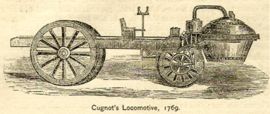
Steam tricycle
Encyclopedia

Steam engine
A steam engine is a heat engine that performs mechanical work using steam as its working fluid.Steam engines are external combustion engines, where the working fluid is separate from the combustion products. Non-combustion heat sources such as solar power, nuclear power or geothermal energy may be...
three-wheeled vehicle.
History
In the early days of motorised vehicle development, a number of experimenters built steam-powered vehicles with three wheels.The first steam tricycle – and probably the first true self-propelled land vehicle – was Nicolas-Joseph Cugnot
Nicolas-Joseph Cugnot
Nicolas-Joseph Cugnot was a French inventor. He is believed to have built the first self-propelled mechanical vehicle...
's 1769 Fardier à vapeur (steam dray), a three-wheeled machine with a top speed of around 3 km/h (2 mph) originally designed for hauling artillery
Artillery
Originally applied to any group of infantry primarily armed with projectile weapons, artillery has over time become limited in meaning to refer only to those engines of war that operate by projection of munitions far beyond the range of effect of personal weapons...
. Failing to meet the army's design criteria, no further development was undertaken.
The Long steam tricycle appears to be one of the earliest preserved examples, built by George A. Long around 1880 and patented some time around 1882. One example was built, which after some years of use was dismantled and the parts dispersed. In 1946, one John H. Bateman, with assistance from the 96-year-old Long, reassembled the machine, which is now on display at the Smithsonian Institution
Smithsonian Institution
The Smithsonian Institution is an educational and research institute and associated museum complex, administered and funded by the government of the United States and by funds from its endowment, contributions, and profits from its retail operations, concessions, licensing activities, and magazines...
.
In 1881 the Parkyns-Bateman steam tricycle was demonstrated in England
England
England is a country that is part of the United Kingdom. It shares land borders with Scotland to the north and Wales to the west; the Irish Sea is to the north west, the Celtic Sea to the south west, with the North Sea to the east and the English Channel to the south separating it from continental...
. It used a petroleum-fired steam boiler (making it the first petroleum-powered vehicle), driving a double-acting two cylinder steam engine on the chassis of a Cheylesmore tricycle. Although numerous orders were reportedly placed, British law made such vehicles essentially illegal on the public roads. An example was displayed in the Science Museum
Science Museum (London)
The Science Museum is one of the three major museums on Exhibition Road, South Kensington, London in the Royal Borough of Kensington and Chelsea. It is part of the National Museum of Science and Industry. The museum is a major London tourist attraction....
from 1912 to 1922.
A small steam tricycle was built by Albert, Comte de Dion in 1887. This had two wheels in the front, between which was mounted the boiler, and a single rear wheel driven by the engine. It was fitted with pneumatic tyre
Tire
A tire or tyre is a ring-shaped covering that fits around a wheel rim to protect it and enable better vehicle performance by providing a flexible cushion that absorbs shock while keeping the wheel in close contact with the ground...
s.
In the same year Léon Serpollet also constructed a coal-fired steam tricycle, with the "steam generator" (boiler) mounted between two rear wheels.
These and other experimenters also built four-wheeled steam-powered vehicles.
The invention of the internal combustion engine
Internal combustion engine
The internal combustion engine is an engine in which the combustion of a fuel occurs with an oxidizer in a combustion chamber. In an internal combustion engine, the expansion of the high-temperature and high -pressure gases produced by combustion apply direct force to some component of the engine...
led to the replacement of steam in most cases, although steam car
Steam car
A steam car is a light car powered by a steam engine.Steam locomotives, steam engines capable of propelling themselves along either road or rails, developed around one hundred years earlier than internal combustion engine cars although their weight restricted them to agricultural and heavy haulage...
s continue to be built to the present day in small numbers.
See also
- History of steam road vehiclesHistory of steam road vehiclesThe history of steam road vehicles describes the development of vehicles powered by a steam engine for use on land and independent of rails; whether for conventional road use, such as the steam car and steam waggon, or for agricultural or heavy haulage work, such as the traction engine.The first...
- SteamrollerSteamrollerA steamroller is a form of road roller – a type of heavy construction machinery used for levelling surfaces, such as roads or airfields – that is powered by a steam engine...
- Timeline of transportation technologyTimeline of transportation technology-Antiquity:*Stone Age – Dugout canoes*3500 BC – Wheeled carts are invented in Mesopotamia*3500 BC – River boats are invented *3100 BC – Horses are tamed and used for transport Botai Egypt *2000 BC – Chariots built by Indo-Iranians...
- Traction engineTraction engineA traction engine is a self-propelled steam engine used to move heavy loads on roads, plough ground or to provide power at a chosen location. The name derives from the Latin tractus, meaning 'drawn', since the prime function of any traction engine is to draw a load behind it...

